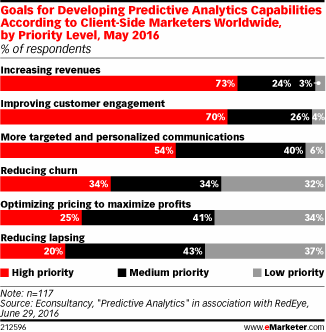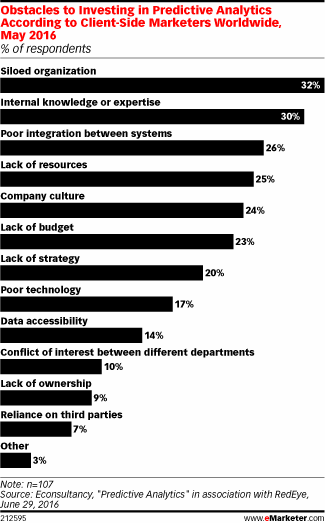 The global predictive analytics market is expected to grow to more than US$ 9 billion by 2020, according to Markets and Markets, mainly because of the transformation from traditional Business Intelligence (BI) techniques to advanced analytics techniques and massive surge of structured and unstructured data.
The global predictive analytics market is expected to grow to more than US$ 9 billion by 2020, according to Markets and Markets, mainly because of the transformation from traditional Business Intelligence (BI) techniques to advanced analytics techniques and massive surge of structured and unstructured data.
 Dealing in general with extracting information from data and using it to predict trends and behavior patterns, help marketers to provide improved personalization, understand user behavior across devices and anticipate consumer needs. To no surprise it is gaining plenty of traction with client-side marketers and agency-professionals alike. The majority of marketers who turn to predictive analytics hope to use the technology to increase revenue (73%) and customer engagement (70%), as eMarketer’s recent study reveals.
Dealing in general with extracting information from data and using it to predict trends and behavior patterns, help marketers to provide improved personalization, understand user behavior across devices and anticipate consumer needs. To no surprise it is gaining plenty of traction with client-side marketers and agency-professionals alike. The majority of marketers who turn to predictive analytics hope to use the technology to increase revenue (73%) and customer engagement (70%), as eMarketer’s recent study reveals. Among those marketers who already use or plan to use predictive analytics, the technique is also useful in providing a variety of customer insights. Around 83% said they used or planned to use predictive analytics to better understand customers.
Among those marketers who already use or plan to use predictive analytics, the technique is also useful in providing a variety of customer insights. Around 83% said they used or planned to use predictive analytics to better understand customers.
Besides, 40% or more of agency professionals and client-side marketers said they either currently use the technology or have set aside a budget to implement a predictive analytics program in the next 12 months, according to data on predictive analytics from eConsultancy and marketing automation firm RedEye.
Still, even as predictive analytics gains steam with more organizations, many companies continue to hold back due to factors like lack of budget, siloed teams and a lack of internal knowledge. Indeed, 40% of agency professionals said lack of budget was a key obstacle. On the client side, 32% of respondents said siloed organizations were holding back their predictive analytics strategies, while 30% mentioned the lack of internal knowledge.
Source: eMarketer.com


